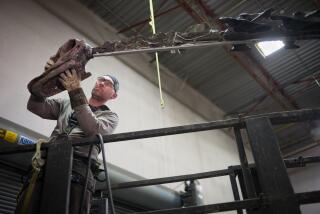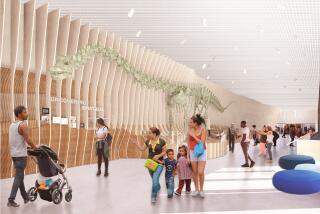Bare-bones mystery
- Share via
TV viewers seem addicted to the popular forensic dramas “CSI: Miami,” “CSI: NY” and “CSI: Crime Scene Investigation.” But those shows are nothing like the new procedural that is unfolding for visitors to the Natural History Museum of Los Angeles County, where the case dates back 66 million years.
Call this show “CSI: Carter County,” after the Montana badlands where the “victim” was discovered -- a teenage Tyrannosaurus rex called Thomas, stumbled upon by teacher and amateur fossil enthusiast Robert Curry, who named it after his brother, a fellow fossil fan.
For the next 18 months, visitors will be able to watch the experts at work trying to solve the mysteries of the dinosaur’s life and death in the museum’s new Thomas the T. rex Lab, a “paleo-odyssey.”
Since 2003, a team of researchers led by Luis Chiappe, director of the museum’s Dinosaur Institute, has been excavating the government-owned site in Montana and bringing back chunks of earth containing the bones of Thomas, who, with 70% of his skeleton unearthed, ranks among the most complete T. rexes in the world. The most complete -- 90% -- is Sue, housed at Chicago’s Field Museum.
At the Natural History Museum, the team will go through the complex and painstaking task of readying the fossilized bones for assembly and mounting as centerpiece in the renovated dinosaur galleries, scheduled to reopen in 2011. The renovation is part of an ongoing $84-million restoration of the historic 1913 museum building, which will begin reopening its galleries in 2010.
In the past, Chiappe says, dinosaur fans were content to be impressed by “superlatives,” such as age or size. Thomas, for example, would have measured about 30 feet long and 10 feet high at the hip (Sue is about 42 feet long) and would have weighed about 8,000 pounds. But now, in part because of the “CSI” phenomenon, Chiappe says, “people care more about the process -- how do you know that? Of course, a big dinosaur is going to sell, but the interest has shifted.”
“This is a crime scene, and it’s a 66-million-year-old crime scene,” Chiappe added, “and you have your forensic team going into the field and figuring out what happened.”
It was the growing public interest in such matters that led the museum to decide to put the process on view. However, Chiappe says, visitors should expect not a dramatization of the process but the chance to peek inside a working lab. “This is a lab within an exhibit. We didn’t want the lab itself to be an exhibit,” he says. “This is the real thing.”
He adds: “Most people think it’s the way they see it on television -- there’s a skeleton lying on the ground, and you just remove the sand with a brush and pick up the pieces and put them together. That’s very far from the truth.”
The job of constructing the lab fell to the Los Angeles architecture firm Hodgetts + Fung, which has been involved in the design of fine art galleries for museums but is new to the world of natural history, according to Craig Hodgetts, its principal architect.
Instead of trying to re-create the dusty chaos of the museum’s existing labs, Hodgetts says, the firm opted for a scientific clean room that resembles something one might find at NASA.
In a sense, the architects took their cues from Hollywood.
“When we thought about how to do it,” Hodgetts says, “there were two courses we might have taken: either the Indiana Jones approach -- we all know that kind of character and explorer, with the hat and all that -- or a fresh, kind of avant-garde approach.
“The museum is full of Indiana Jones-type experiences. In the design of this thing, all of our models were like the movie ‘2001.’ I think it’s going to break ranks with the kind of presentation that is more traditional in natural history museums.”
The lab, which opened to the public Sunday, features two airtight lacquered “pods” with windows, through which viewers can observe the gloved hands of researchers stripping away the earth and stones surrounding the bones, some of which may yet await discovery. On the side of each pod is a “visitor interface” area where museum-goers can engage in a simulated discovery process, assembling a synthetic T. rex bone and cataloging it for collection.
Chiappe says that because Thomas died at about 13 years of age, this “sub-adult” fills a gap in the museum’s T. rex life cycle, which includes the youngest-known T. rex (it died at about age 2) as well as a juvenile and adults.
One thing Thomas can’t tell paleontologists, Chiappe says, is whether the dinosaur was male or female. Same with Sue, who could be a boy named Sue. It’s complicated, but the only way so far to determine whether a T. rex is female is to discover one that died during the egg-laying period, which produces temporary changes in the medullary bone, Chiappe says.
But with dinosaurs, knowledge is a numbers game, and Thomas may lend clues to other sexual determinants, such as body size -- maybe the males were bigger than females, maybe the other way around. Also, the structure of Thomas’ skull indicates he may have had a tumor that could have caused his death or, even if not, it might offer clues to pathology in the species.
“T. rex is a well-known dinosaur. It’s not that you’re going to find something new in the shape of the skull and things like that, but it’s a new piece of the puzzle,” Chiappe says. “By having so many specimens now, we are learning about when they reached sexual maturity, their rates of survival, their longevity; many interesting questions you wouldn’t be able to answer with one specimen.”
--
More to Read
Sign up for The Wild
We’ll help you find the best places to hike, bike and run, as well as the perfect silent spots for meditation and yoga.
You may occasionally receive promotional content from the Los Angeles Times.






